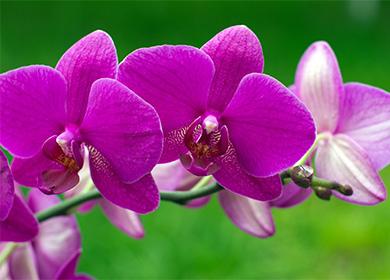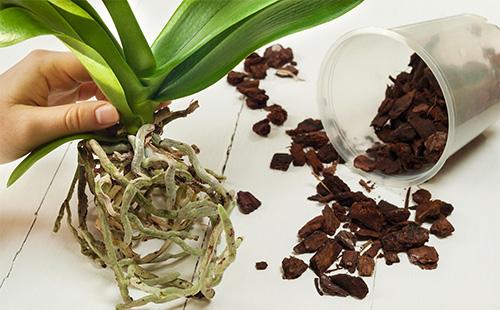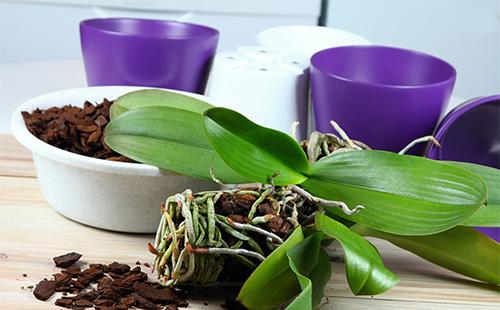The content of the article
Phalaenopsis are epiphytic, some species are lithophytic plants. Epiphytes grow on trees, lithophytes settle among stones. The natural habitat of phalaenopsis is a humid tropical climate. The name translates as "night butterfly." Phalaenopsis flowers really resemble fluttering butterflies.
Botanical Description
Phalaenopsis belong to the orchid family. Allocated to a separate genus, consisting of 70 major varieties. The bulk of the plants in the stores are hybrid cultivars bred artificially. By structure, they are monopodial orchids (they have one growth point). Peduncles and aerial roots grow from leaf sinuses. The following structural features are characteristic.
- Aerial roots. The outer layer is a porous hygroscopic fabric that absorbs and retains moisture. Due to the content of chlorophyll, they turn green. The root system is directly involved in photosynthesis.
- The leaves are wide, evergreen. Four to six leaves grow simultaneously on an adult plant. Healthy foliage is a pleasant olive green color, sometimes with a marble pattern.
- Peduncle axillary, branched. In length reaches 80 cm. There are tilted and upright. The number of flowers on one peduncle is from 3 to 20 pieces.
- Large flowers of different colors. Distributed white, pink, cream, purple shades. Variegated and multicolor varieties are bred. Some flowers exude a pleasant aroma.
Common varieties
Not all species are suitable for growing in an apartment. Some are too capricious, others grow only in greenhouses. But each species has additional varieties. Sit the following popular types of Phalaenopsis orchids.
- Phalaenopsis giganthea. It differs from other species by unusually large leaves. It blooms profusely with small flowers of different colors. The aroma contains citrus notes.
- Horse phalaenopsis. It blooms almost all year round. Peduncle is not very long, branched, abundantly strewn with buds. The flowers are small, delicate pink.
- Phalaenopsis amabilis. Large flowers with a very pleasant aroma. They do not fade for a long time. The color is varied. One of the species that is actively used for breeding.
- Phalaenopsis Ludemann. The flowers are small in their original colors. On a pink or purple background, purple dots are densely scattered. The aroma is delicate, very pleasant. Long flowering due to the alternate opening of flowers.
- Phalaenopsis is pink. Compact orchid with a short curved peduncle. The leaves are dark with a reddish tinge. The flowers are small bright pink or white.
Purchase of phalaenopsis and its adaptation
Growing Phalaenopsis orchids at home begins with the selection of a seedling. The further growth rate largely depends on the correct choice and adaptation conditions.
Criterias of choice
You need to buy phalaenopsis in flower shops, and not with it. If possible, it is advisable to clarify the delivery date. Often sellers in stores take care of plants incorrectly. This leads to diseases and even death of the plant. What else to look for when buying phalaenopsis?
- Content. Shelves for plants should be clean, dry, without water under the pots. Leakage of excess fluid indicates overmoistening. In summer, this is acceptable, but in winter it is fraught with rot.
- Ground condition. Phalaenopsis will easily transport if the soil is dry. The standard substrate is coniferous bark or sphagnum. The substrate should not be too dense. Look for mold.
- Pot. Choose phalaenopsis in a clear plastic container. Through transparent plastic, roots are better visible.
- Sustainability. Gently grab the orchid at the base of the stem and move it slightly. She should sit well in a pot. Instability indicates a recent transplant - such a plant may not take root.
- The roots. Normally, the roots are dense and elastic. The roots are light in dry soil, and green in moist soil. A brown or gray hue indicates problems with the root system.
- Pseudobulbs. It is not recommended to buy a plant with withered, shriveled pseudobulbs.
- Leaves. A healthy phalaenopsis leaves are dense, elastic, uniform green color. A very bright color with an intense glossy shine may indicate an excessive amount of nitrogenous fertilizers. This is fraught with flowering problems.
- Pests. Carefully inspect the plant for signs of pests. Look at the underside of the sheet.
Adaptation to the conditions of the apartment
How to care for Phalaenopsis orchid after purchase? Phalaenopsis must get used to the new conditions, go through a period of adaptation. At this time, he needs special care.
- Packaging. The first day the transparent packaging is not removed. It smooths out a sharp change in humidity and temperature.
- A place. They are placed in a slightly shaded place, protected from the action of sunlight and drafts.
- Watering. The first week phalaenopsis is not watered. In stores they are watered abundantly. In the depths of the pot, the substrate may be moist. In winter, watering begins ten days after purchase.
- Quarantine. Withstand ten-day quarantine. Phalaenopsis is kept separate from other indoor plants.
- The first feeding. It is carried out in three weeks in the summer, in a month - in the winter. In store conditions, all plants receive large doses of fertilizer to maintain their presentation.
Care Basics
Judging by the reviews, even beginners have no serious difficulties with leaving. The only requirement is to adhere to the recommended microclimate and basic rules.
- Lighting. Bright, long-lasting, but diffused. The daylight hours are about 12 hours. In the dark winter months, additional lighting is installed. Once every ten days, phalaenopsis is turned the other side to the light for uniform development. During the laying of the buds, the flower is not disturbed.
- Temperature. In summer, adhere to a temperature range of 20-25 ° C, in winter 18-20 ° C. Achieve daily temperature fluctuations within 5-7 ° C. Protect from cold drafts and heat. In warm weather, you can take out phalaenopsis on the street or balcony.
- Watering. One of the main requirements is to properly water the Phalaenopsis orchid. Between watering, the soil should dry to the bottom. Watering specific - the pot is lowered for 15-20 minutes in warm water. The indicator of sufficient moisture saturation is the green color of the roots. The pot is placed on a wire rack, the excess liquid is drained and the orchid is returned to its place. During flowering, use the standard watering method.
- Humidity. The minimum humidity level is 40%. When spraying do not allow water to accumulate in the axils of the leaves. This inevitably leads to decay. It is better to spray the air around the phalaenopsis than the plant itself. Periodically, an orchid is bathed in the shower. After bathing, wipe the leaves dry.
- Top dressing. Specialized fertilizers for orchids are used. Frequency - weekly with a decrease in the concentration of the drug by half. Can be fed with universal mineral complex "Kemira". Concentration - 1 g per liter of water.
- The soil. The substrate is made up of crushed pine bark, less charcoal, perlite and sphagnum are added. The proportions of additives depend on the microclimate of the apartment. At low humidity, sphagnum occupies a third of the total soil volume. Its task is to absorb water during irrigation, then gradually give it to the roots. In conditions of high humidity, the content of sphagnum in the soil mixture is minimized.
- Transfer. It is rarely transplanted. The signal for transplantation is caking of the soil, its salinization, acidification, decomposition, tightness of the root system. Florists do not recommend replanting a flowering orchid with phalaenopsis - wait until the flowering ends.
Reasons for the lack of flowering
If phalaenopsis does not bloom, then the conditions of detention or care are violated. This is a plant with pronounced seasonality. In the life of phalaenopsis, periods of active growth and rest continuously occur. The lack of flowering can be caused by the fact that the conditions of the dormant period are not observed. And also with the following factors.
- Lack of light. Phalaenopsis is placed on a well-lit place, protected from the sun. In autumn, winter and early spring, they are illuminated with artificial light. Light is an important condition for laying flower buds.
- Excess fertilizer. Regular fertilizer application with a high nitrogen content stimulates the growth of phalaenopsis, but slows down the formation of the peduncle. Top dressing is best stopped before flowering.
- No daily temperature fluctuations. Temperature fluctuations day and night should be 5-7 ° C.
Care after flowering
After flowering, the phalaenopsis orchid undergoes a series of changes - the peduncle begins to dry out, the plant prepares for a dormant period. But this does not always happen. Sometimes the peduncle stays green. This means that new flowers may appear on it.
Feed phosphorus, potassium and wait a bit. If nothing happens within two to three weeks, cut the peduncle to the first sleeping bud. Pruning stimulates their awakening, lateral shoots with buds will appear.
If the peduncle quickly turns brown and shrinks, it is better to prune phalaenopsis immediately after flowering. Pruning is carried out with a sharp sterile secateurs. Slices are treated with ground cinnamon, charcoal powder or brilliant green. Hollow peduncles are covered with beeswax.
Breeding methods
Propagating phalaenopsis is more difficult than some other types of orchids. It belongs to the monopodial type of orchids - it has only one growth point. Material for propagation can be taken only from adult, healthy plants that are not damaged by fungus, insects, rot.
Kids
Features Children are formed on the peduncle. You can separate them a couple of months after flowering. The formation of children is typical for orchids no younger than two years old. You can separate the offspring after the appearance of roots or at least two leaves.
Step-by-step instruction
- Gently cut the baby. Slices are treated with carbon powder. Dry the baby for a day in a ventilated, shaded place.
- Fill disposable cups with soil from the bark and sphagnum. Grind the soil beforehand. Moisten the substrate.
- Dilute "Kornevin" in accordance with the instructions. Dip a section of the baby in the solution and plant it in the prepared soil.
- Create greenhouse conditions - cover a young plant with a film or a jar. Put in a bright place with a temperature of 23-25 ° C, systematically moisten and ventilate.
Rooting cuttings
Features If the children have not formed, you can root parts of the peduncle. From the moment of flowering, no more than two to three months should pass. Cuttings cut later will not take root even with growth stimulants and rooting agents.
Step-by-step instruction
- Cut the peduncle at the base. Treat the slices with carbon powder or cinnamon. Stump from a peduncle smear with beeswax.
- Cut the peduncle into cuttings of 7 cm. On each segment, leave one or two buds.
- Moderately moisten the crushed sphagnum with a growth stimulant solution. Lay the pieces horizontally on the moss.
- Cover the container with foil. Maintain a temperature of 25-28 ° C, keep in good light at a humidity of about 70%. Periodically spray the moss with a root stimulant.
- When the roots grow to 5 cm, the first pair of leaves will appear, plant the rooted cuttings in separate pots.
Division
Features Even experienced gardeners rarely resort to division. The likelihood of death of the phalaenopsis is too high. Only large, adult, healthy plants are divided for at least four years. The minimum number of leaves on the stem is from six pieces.
Step-by-step instruction
- Disinfect a sharp knife. Gently cut off the top. The place of cut is the middle of the plant. Two or four leaves should remain on the mother plant. Slices are treated with coal powder.
- Plant the top in a dry substrate from the bark and sphagnum. Periodically spray the soil with a growth stimulator, maintain the temperature to 25 ° C, and humidity to 50%.
- After the appearance of young leaves, transplant into a pot.
For circumcised phalaenopsis, provide enhanced care. Mandatory additional lighting, regular dressing. After two to three months, a kidney should form just below the cut, from which new shoots will appear over time. It takes at least a year and a half to restore Phalaenopsis.
Diseases and treatments
The main diseases of the phalaenopsis orchid are fusarium, urticaria, boronitis. These are infectious diseases that cause rot, leading to the death of the plant. Meet infrequently. The main reason is the purchase of an already infected phalaenopsis. Common signs - leaves wither, black spots appear, the root system rots, flowers fall.
Phalaenopsis orchid treatment is a combination of normalization of conditions with treatment with fungicides and bactericidal preparations. You can use Topsin-M or Fundazole. Watering reduces, keep phalaenopsis in a warm room, provide constant air circulation.
Being attacked by pests. Yellow leaves, their fall indicates a mealybug. The appearance of a silver spider web - on a spider mite. The shield will be given sticky leaves, the appearance of bright spots on their surface. All insects are treated with insecticides - Inta-Vir, Actellik, and Aktara.
Caring for the Phalaenopsis orchid is not simple, but interesting. If you are just starting to get involved in orchids, then every day you will discover something new - interesting features, beautiful varieties and different flavors.




